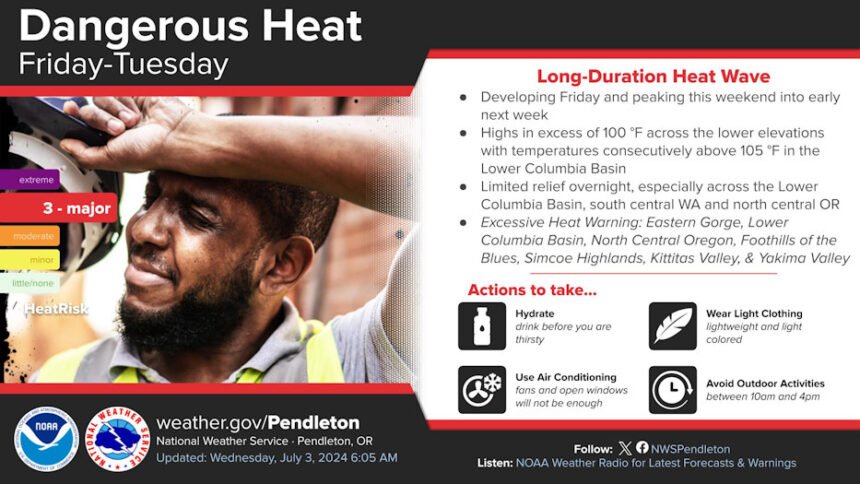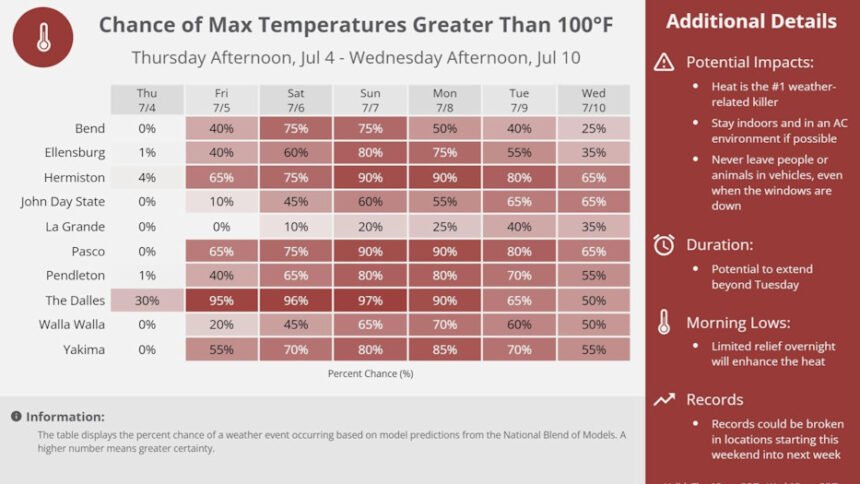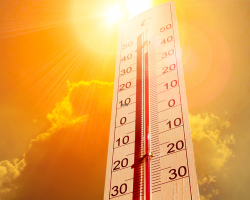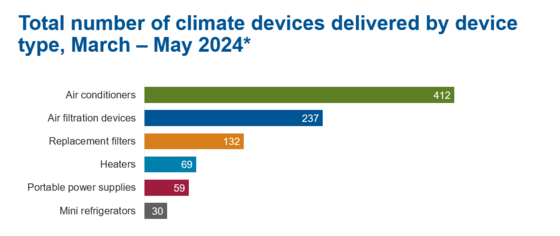Deschutes County Health offers tips to stay cool, safe; Shepherd’s House, Council on Aging provide cooling centers


(Update: adding video, comment from Deschutes County Health, Council on Aging, Shepherd's House)
OHA also has health tips as state distributes air conditions, OSHA reminds of worker protection rules
BEND, Ore. (KTVZ) -- With much of Oregon facing triple-digit temperatures in coming days, Central Oregon and state agencies are offering tips and taking other steps to help residents avoid the potentially negative impacts of the extensive heat.
Trevor Duncan praised the Shepherd's House Lighthouse Navigation Center: "They have been the fundamental guiding light to survival, so overall really pleased with the Shepherd Navigation Center."
Duncan has been using the facility's resources for three years, added, "We're a community and family, and I think we would suffer far more if we didn't have the Shepherd being a part of our situation."
The Lighthouse Navigation Center is one of nine cooling centers set up or listed by Deschutes County Health Services. They're anticipating 130 people during the expected heat wave.
Evan Hendricks, director of navigation, told NewsChannel 21, "Being able to provide a safe refuge that folks can access with as few barriers as possible, and to be able to then give them access to basic services is just it's at the core of who we are and what we do."
He says providing spaces like this is crucial due to preventing heat stroke, exhaustion and dehydration, especially when heat waves hit.
Emily Horton, Deschutes County's emergency preparedness manager, said, "It's really important that we look for headache, nausea, dizziness, weakness, irritability, thirst, heavy sweating or elevated body temperature. If any of these things are starting to happen, it's really important to move someone to a cooler area."
She says the key to beating the heat is hydration and maintaining low body temperature.
Emma Fired-Cassorla, director of communications with the Council on Aging of Central Oregon, said, "Some people are actually eligible to get air conditioners for free, as well as air purifiers. So if you are on Medicaid, we would suggest that you call the local DHS office to see if there's any available, to see if you are eligible for that program."
The Council on Aging runs another cooling center. It's open to any adult 60 or older from 8:30 a.m. to 4 p.m.
"A lot of times, someone who is homebound is going to be the most susceptible to the heat, because they can't necessarily escape," Fried-Cassorla said. "So we have people who are going and checking in on them daily or multiple times a week, to make sure they're doing okay."
In addition to accessing cooling centers, the county recommends going to public indoor spaces like the grocery store, movie theater or gym.
Paul Bishop, a patron of the Council on Aging., said, "Take a shirt, get it wet, put it on. And it's really difficult to put on because it's wet. And I would say just get wet and stand in front of a fan if you don't have A/C."
Cooling centers recommend checking in on neighbors, specifically those who may be living alone. The county is also providing heat stress kits to those who can't go to the cooling shelters. They include water, electrolyte tablets, a cooling pack, a cooling towel and a Mylar blanket.
Here are news releases from the Shepherd's House, the county and state agencies:
Shepherd's House to Provide Cooling Shelters in Bend and Redmond (Photo)
Shepherd's House Ministries - 07/03/24 9:52 AM
Facilities will open to offer relief to unhoused neighbors during the extreme heat wave
BEND and REDMOND, July 3—In a crucial response to the forecasted extreme heat wave, Shepherd’s House Ministries is offering a safe and cool refuge for those experiencing homelessness at two locations: the Lighthouse Navigation Center temporary location at 181 NE Franklin Ave, Bend, OR 97701, and the Redmond Center at 1350 S Hwy 97, Redmond, OR 97756.
With daytime temperatures expected to exceed 100 degrees for several consecutive days, the cooling shelters aim to mitigate the risks of dehydration and heat-related illnesses among the unhoused population.
Curt Floski, Executive Director, highlighted the critical nature of this initiative: “Extreme heat presents serious health hazards, particularly for those lacking proper shelter. At Shepherd’s House Ministries, our mission is to support the most vulnerable in our community by offering essential services and a safe, cool environment. We deeply appreciate the community's support in making this possible.”
Additionally, the Shepherd’s House mobile outreach program will provide showers at site locations and distribute water bottles and other essentials around Bend, checking in on those living without shelter during the heatwave.
CALL TO ACTION: The community is strongly encouraged to support this initiative by donating water bottles at Shepherd’s House Donation Center in Bend, 1854 NE Division St, Bend, OR 97701, or the Redmond Center. Community support is crucial in making this initiative a success. To volunteer or make a financial contribution, please visit www.shministries.org.
Deschutes County Health Services offers tips to stay safe in the summer heat

Temperatures are expected to climb above 100 degrees in Central Oregon this weekend and Deschutes County Health Services is reminding the community to stay cool, stay hydrated and to watch out for one another when it’s hot outside.
“As temperatures increase, so do heat-related illnesses. A heat-related illness can be deadly and can affect anyone, regardless of their age, gender or health status,” said Dr. Richard Fawcett, Deschutes County Health Officer. “We encourage everyone to protect themselves and others during the extreme heat this weekend.”
Public Health suggests the following strategies to stay healthy and safe:
- Drink more water than usual and don’t wait until you’re thirsty.
- Always carry bottled water with you and bring extra for others.
- Avoid alcohol and sugary drinks.
- Plan to do outdoor activities in the early morning when temperatures are lower.
- Wear light weight, loose fitting clothing.
- Stay in an air-conditioned location as much as possible. If your home doesn’t have air-conditioning, spend time in a public library or a designated cooling center.
- Stay indoors during the hottest part of the day, usually between 3 p.m. and 7 p.m.
- Don’t rely on electric fans. They may provide comfort, but they do not prevent heat-related illnesses when temperatures are above 90 degrees.
- Avoid using your stove and oven to maintain a cooler temperature in your home.
- Never leave children or pets in a parked car, even with the window rolled down. Cars heat up very quickly and can put them at risk of heat stroke.
Older adults, children, people with chronic illnesses and those who are working and/or living outdoors are at greater risk of heat-related illness. Public Health recommends checking on friends and family members when it’s hot, and to know the signs and symptoms of heat exhaustion and heat stroke.
Symptoms of heat exhaustion include:
- Headache
- Nausea
- Dizziness
- Weakness
- Irritability
- Thirst
- Heavy sweating
- Elevated body temperature
- Decreased urine output
If you or others are experiencing symptoms of heat exhaustion, take steps to cool down right away and seek medical help if the symptoms don’t improve. Heat exhaustion can lead to heat stroke.
Symptoms of heat stroke include:
- Confusion, altered mental status, slurred speech
- Loss of consciousness (coma)
- Hot, dry skin or profuse sweating
- Seizures
- Very high body temperature
If you, or others have symptoms of heat stroke call 911. Heat stroke can cause death or permanent disability without emergency treatment.
--
Oregon Health Authority - 07/02/24 4:01 PM
July 2, 2024
Heat advisories prompt OHA warning about heat-related illness
Tips for staying cool include limiting sun exposure, wearing light clothing, knowing signs of heat stroke
PORTLAND, Ore. – Oregon Health Authority is encouraging people to take steps to avoid heat-related illnesses such as heat stroke and heat exhaustion as advisories predicting triple-digit temperatures go into effect this week.
Older adults, infants and children, those who live or work outdoors, have low incomes, or who have a chronic medical condition are particularly vulnerable to the effects of extremely high temperatures. Heat-related illnesses among these groups are likely to increase as heat waves occur more often than usual – and at higher temperatures – around the state.
OHA offers these tips to stay safe and healthy during extreme heat:
1. Stay cool.
- Stay in air-conditioned places, if possible.
- Limit exposure to the sun from 10 a.m. to 6 p.m. when temperatures are hottest, and avoid direct sunlight. Schedule outdoor activities in the early morning and late evening.
- Open windows to allow fresh air to circulate if it cools off in the morning and evening hours. Close shades on south and west-facing windows during afternoon hours.
- Use portable electric fans to push hot air out of rooms or draw in cooler air, but don’t rely on a fan as a primary cooling device.
- Wear loose-fitting, lightweight and light-colored clothing to keep cool and protect skin from the sun. Dress infants and children similarly.
- Use cool compresses, misting and cool showers or baths to lower your body temperature.
- Avoid hot foods and heavy meals, which increase body heat.
- Never leave infants, children or pets in a parked car
- Check on at-risk friends, family and neighbors several times a day. Heat-related illnesses can make it hard to think clearly. This means people may be in danger without realizing it. Make sure loved ones have what they need to stay cool.
2. Stay hydrated.
- Regardless of your level of activity, drink plenty of fluids, even if you are not thirsty, and especially when working outside.
- Avoid alcohol or liquids containing large amounts of sugar, which can increase dehydration. Alcohol can be especially dangerous when used as a substitute for water hydration, and increases risks of alcohol-related injuries.
- Make sure your family, friends and neighbors drink enough water.
3. Stay informed.
- Keep up to date on the heat risk and heat index when planning activities so you can find ways to stay cool and hydrated.
- Learn how to prevent, recognize and treat heat-related illnesses.
- Heat-related illness can develop in as little as 10-15 minutes. It can happen indoors and outdoors.
- Some heat-related illnesses can be managed at home or at urgent care. However, if you or someone you see is experiencing confusion or unconsciousness due to heat exposure, call 911. It is a medical emergency.
Ways to stay cool without an air conditioner:
- Air conditioners can help you stay cool, but not everyone has one. Visiting friends with an air conditioner or going to cooling centers in your community can help you stay cool.
- Local houses of worship and libraries may be open to the public during times of extreme heat. Splash pads and shopping centers can also be places to cool off.
- Water is also great for cooling you off when it’s hot. Drape yourself with a damp towel, take a cool bath or shower or take a dip in a fountain. These actions can help cool you off in a hurry and work better when it’s not humid.
- If you have a cooler part of the house, such as a basement, spend time there during the hottest parts of the day.
For more information, visit OHA’s website: www.oregon.gov/heat.
Air conditioners for eligible OHP members
Oregon launched new climate-related benefits as part of the state’s federally funded expansion of Oregon Health Plan (OHP) coverage, which includes health-related social needs (HRSN) services that help maintain health and well-being but are not traditionally thought of as medical services. New services include providing climate-control devices such as air conditioners, air filters, mini refrigeration units and portable power supplies to eligible OHP members.
OHP members interested in receiving climate devices should contact their coordinated care organization (CCO) to learn more. OHP Open Card members can call 1-888-834-4304 or email ORHRSN@acentra.com. If an OHP member is not sure which plan or CCO they are in, they can call the OHA Client Services Unit at 1-800-273-0557.
OHP members who don’t qualify for HRSN climate devices can still contact their CCO to see if climate supports are available through “flexible services” (also called “health-related services”). OHP Open Card members who don’t qualify for HRSN climate devices can still contact 1-888-834-4304 or their county to learn about local programs providing climate supports this summer. For non-OHP members in Oregon, some cities and counties have similar programs with a limited supply of devices.
Contact 211
During periods of extreme heat, counties often open cooling spaces for local communities to seek relief from high temperatures; these will be listed here, by county, based on the information shared with 211 by the shelter providers. Opening hours are based on specific counties' and individual agencies' criteria.
Methods to contact 211:
- CALL 211 or 1-866-698-6155 or TTY: dial 711 and call 1-866-698-6155, 24 hours per day, 7 days per week.
- TEXT your ZIP code to 898211 (TXT211), Monday to Friday, 9 a.m. to 5 p.m.
- EMAIL help@211info.org, Monday to Friday, 9 a.m. to 5 p.m. (Language interpreters available by phone; text and email in Spanish and English)
If there is a shelter that is not listed online, or information that needs to be edited, please email 211’s resource team: t@211info.org">support@211info.org.
During times of emergency incident response, 211’s answer rate may vary
--
Oregon Health Authority - 07/02/24 3:21 PM
July 2, 2024
Oregon distributes nearly 1,000 air conditioners, air filters and other climate-control devices to Oregon Health Plan members
SALEM, Ore. – Three months after Oregon launched the nation’s first climate-related benefits tied to Medicaid coverage, nearly 1,000 eligible Oregon Health Plan (OHP) members have received vital devices to help keep them healthy.
These devices include air conditioners, heaters, air filters, mini refrigeration units for storing medications, and portable power supplies to operate medical equipment (i.e., ventilators during power outages). Air conditioners made up 44% of the 939 devices distributed from March 1 to May 31.

OHA and partners are working to distribute climate devices to eligible OHP members ahead of heat waves and wildfires this summer. Oregon recorded its hottest years in state history during the last five years, and climate models show the severity of heat waves are likely to increase.
The new climate-related benefits are part of Oregon’s federally funded expansion of OHP coverage, which includes health-related social needs (HRSN) services that help maintain health and well-being but are not traditionally thought of as medical services.
The state is first extending eligibility for climate devices to people who are experiencing life transitions. This includes people who are: currently or previously involved in the Oregon child welfare system; homeless or at risk of becoming homeless; transitioning to dual eligibility for Medicare and Medicaid; adults and youth recently discharged from Institutions for Mental Disease (IMDs) or released within the last year from incarceration. To be eligible, members cannot live in a group setting or shelter and need access to consistent and safe power to use these devices. Climate resources must also be part of a member’s health need or treatment.
“Our climate is changing and the way we deliver health care has to change with it,” said Dave Baden, deputy director of OHA. “People with lower incomes and chronic conditions are among those most likely to experience heat exhaustion, heat stroke or complications of other health conditions related to extreme climate events. Access to these services will reduce health disparities and offer life-saving resources to people in Oregon.”
OHP members interested in receiving climate devices should contact their coordinated care organization (CCO) to learn more. OHP Open Card members can call 1-888-834-4304 or email ORHRSN@acentra.com. If an OHP member is not sure which plan or CCO they are in, they can call the OHA Client Services Unit at 1-800-273-0557.
OHP members who don’t qualify for HRSN climate devices can still contact their CCO to see if climate supports are available through “flexible services” (also called health related services). OHP Open Card members who don’t qualify for HRSN climate devices can still contact 1-888-834-4304 or their county to learn about local programs providing climate supports this summer. For non-OHP members in Oregon, some cities and counties have similar programs with limited supply of devices.
HRSN services are part of Oregon’s 2022 - 2027 1115 Medicaid waiver, which helps provide more federal funding and expanded coverage to OHP members. Medicaid waivers give states the flexibility to test new ways to deliver and pay for Medicaid benefits, with approval from the Centers for Medicare and Medicaid (CMS). Oregon’s 1115 waiver includes several first-in-the-nation benefits tied to Medicaid coverage.
To learn more about OHA’s new climate-related resources, visit the web site.
Data included is taken from three sources:
- CCO "Exhibit L" Quarterly Report for January - March 31, 2024;
- Open Card contractor settlement reports for March, April and May 2024; and
- A supplemental survey of CCOs to report climate devices delivered to CCO members in April and May 2024.
All data is preliminary and may be subject to change, so should be interpreted with caution.
--
As temperatures rise, Oregon OSHA reminds employers to protect workers from the potential dangers of heat illness (Photo)
Oregon Dept. of Consumer & Business Services - 07/02/24 1:11 PM
Salem – As temperatures rise and the risk of heat illness in the workplace increases, Oregon OSHA reminds employers to follow requirements designed to help protect workers from the hazards of extreme heat. The division offers free resources to help employers comply with the requirements.
Oregon OSHA maintains a heat illness prevention rule under which employers must provide adequate water, rest, shade, training, acclimatization – which involves gradually adapting the body to work in the heat – and additional protective measures.
“Employers need to take the potential dangers of heat illness seriously, which means exercising vigilance and focusing on prevention,” said Renée Stapleton, administrator for Oregon OSHA. “We have many free resources to help them comply with our specific requirements, including practical guidance and helpful online trainings they can use now.”
Oregon OSHA’s heat illness prevention requirements apply across industries and where employers provide housing, including on farms. Under the Oregon Safe Employment Act, workers have a right to a safe and healthy workplace, the right to raise concerns free of retaliation, and employers must maintain safe and healthy workplaces.
The division urges employers to refresh their knowledge of the general workplace requirements and employer-provided housing requirements in these fact sheets:
- Key requirements for general workplaces – English/Spanish
- Key requirements for employer-provided housing – English/Spanish
All heat illness prevention resources are available on Oregon OSHA's A-to-Z topic index page. They include a video training in English and Spanish that satisfies certain training elements of the heat rule.
Oregon OSHA also offers:
Consultation services – provides free and confidential help with safety and health programs, including how to control and eliminate hazards, and hands-on training. The services involve no fault, no citations, and no penalties.
- Phone (toll-free in Oregon): 800-922-2689
- Field offices
- Online
- Email: consult.web@dcbs.oregon.gov
Technical staff – helps employers understand requirements and how to apply them to their worksites
- Phone (toll-free in Oregon): 800-922-2689
- Online
- Email: tech.web@dcbs.oregon.gov
The Oregon Department of Consumer and Business Services, which includes Oregon OSHA, maintains the Multicultural Communications Program that provides outreach to communities with limited English proficiency. That outreach encompasses information about on-the-job safety and health.
The Ombuds Office for Oregon Workers provides help with understanding workplace safety and health rights, and workers’ compensation rights.
###
About Oregon OSHA: Oregon OSHA enforces the state's workplace safety and health rules and works to improve workplace safety and health for all Oregon workers. The division is part of the Department of Consumer and Business Services, Oregon’s largest consumer protection and business regulatory agency. Visit osha.oregon.gov and dcbs.oregon.gov.